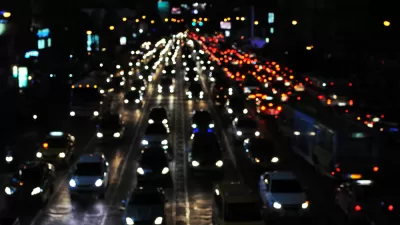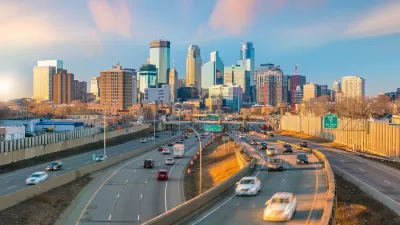Cities with rapidly growing populations and inadequate public transit systems are seeing more gridlock despite changes in commuting patterns and the rise of remote work.

Despite a slight reduction in traffic congestion in most U.S. cities since the start of the pandemic, roads in some of the country’s fastest-growing cities are experiencing more traffic. As Konrad Putzier explains in the Wall Street Journal, “Local roads, built decades ago for a much smaller population, are struggling to accommodate the new reality.”
The article details the potential losses caused by congestion, arguing that gridlock can make regions less productive by discouraging new employers and driving up housing costs in the denser areas nearer to city cores. A recent blog post by Todd Litman argues that congestion costs are not as high as estimated by some, and that other factors should more strongly affect transportation planning decisions.
Putzier’s article points to average traffic speeds as one measure of congestion, particularly in residential areas. However, Putzier does not mention whether traffic calming or other road safety initiatives could have contributed to slower speeds, which are shown to reduce the chance of fatal crashes. It even highlights one Miami-area driver who “said she started driving an SUV to get a higher-perched view of the gridlock in front of her.” Meanwhile, larger SUVs are contributing to higher rates of pedestrian deaths.
Putzier does note that improving public transit, which is often lacking in many Sunbelt cities, can alleviate congestion and make housing more accessible to more residents. However, he highlights complaints that “You’ll see an extra lane here or there, but by and large it just can’t keep up” without acknowledging that this is a tacit admission that building more roadways only induces traffic demand.
FULL STORY: Sunbelt Traffic Jams Are Frustrating Drivers and Threatening Growth

Planetizen Federal Action Tracker
A weekly monitor of how Trump’s orders and actions are impacting planners and planning in America.

San Francisco's School District Spent $105M To Build Affordable Housing for Teachers — And That's Just the Beginning
SFUSD joins a growing list of school districts using their land holdings to address housing affordability challenges faced by their own employees.

The Tiny, Adorable $7,000 Car Turning Japan Onto EVs
The single seat Mibot charges from a regular plug as quickly as an iPad, and is about half the price of an average EV.

Seattle's Plan for Adopting Driverless Cars
Equity, safety, accessibility and affordability are front of mind as the city prepares for robotaxis and other autonomous vehicles.

As Trump Phases Out FEMA, Is It Time to Flee the Floodplains?
With less federal funding available for disaster relief efforts, the need to relocate at-risk communities is more urgent than ever.

With Protected Lanes, 460% More People Commute by Bike
For those needing more ammo, more data proving what we already knew is here.
Urban Design for Planners 1: Software Tools
This six-course series explores essential urban design concepts using open source software and equips planners with the tools they need to participate fully in the urban design process.
Planning for Universal Design
Learn the tools for implementing Universal Design in planning regulations.
Smith Gee Studio
City of Charlotte
City of Camden Redevelopment Agency
City of Astoria
Transportation Research & Education Center (TREC) at Portland State University
US High Speed Rail Association
City of Camden Redevelopment Agency
Municipality of Princeton (NJ)





























